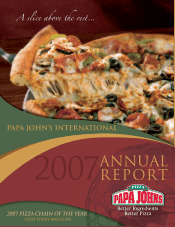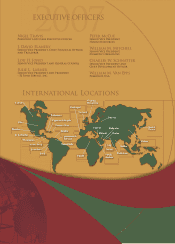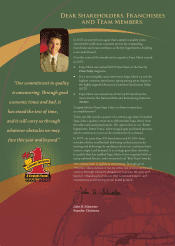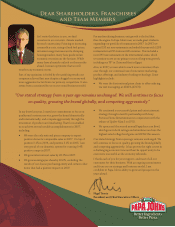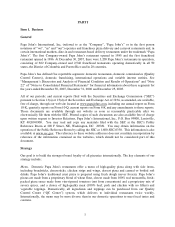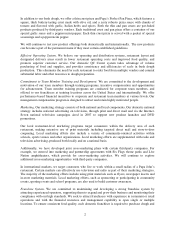Papa Johns 2007 Annual Report Download - page 10
Download and view the complete annual report
Please find page 10 of the 2007 Papa Johns annual report below. You can navigate through the pages in the report by either clicking on the pages listed below, or by using the keyword search tool below to find specific information within the annual report.3
seasoned sauce from our QC Centers and to purchase all other supplies from our QC Centers or approved
suppliers. QC Centers outside the U.S. or in remote areas may be operated by franchisees pursuant to
license agreements or by other third parties. We devote significant resources to provide Papa John’s
franchisees with assistance in restaurant operations, management training, team member training,
marketing, site selection and restaurant design. We also provide significant assistance to licensed
international QC Centers in sourcing high-quality suppliers located in-country or regional suppliers to the
extent possible.
Unit Economics
In 2007, the 541 domestic Company-owned restaurants included in the full year’s comparable restaurant
base generated average annual sales of $836,000, average cash flow (restaurant operating income plus
depreciation) of $156,000 and average restaurant operating income of $132,000. Average cash flow and
average restaurant operating income includes food costs as purchased directly from suppliers (i.e.
excludes margin earned by our QC Centers). This average operating income represents 15.8% of average
sales and the average cash flow represents 59.0% of the $265,000 average investment in property and
equipment for these Company-owned restaurants.
Franchise operating income returns may differ from Company-owned restaurants for a variety of reasons,
including lower average sales volumes for under-penetrated markets, lower average investment costs and
differences in compensation and other costs.
The average cash investment for the 20 domestic Company-owned restaurants opened during the 2007
fiscal year, exclusive of land, was approximately $270,000, excluding tenant improvement allowances
that we received. We expect the average cash investment for the 10 to 15 domestic Company-owned
restaurants expected to open in 2008 to be approximately $270,000, excluding any anticipated tenant
improvement allowances. Substantially all domestic restaurants do not offer dine-in areas, which reduces
our restaurant capital investment.
Development
A total of 263 Papa John’s restaurants were opened during 2007, consisting of 24 Company-owned (20
domestic and four international) and 239 franchised restaurants (140 domestic and 99 international),
while 70 Papa John’s restaurants closed during 2007, consisting of nine domestic Company-owned and
61 franchised restaurants (48 domestic and 13 international).
During 2008, we plan to open approximately 160 to 190 net new units (openings, net of closings). We
expect to open 20 to 25 Company-owned restaurants (10 to 15 domestically and 10 internationally) and
240 to 265 franchise restaurants (105 to 115 domestically and 135 to 150 internationally). We also expect
approximately 100 Papa John’s restaurants to close during 2008, the majority of which are expected to be
domestic franchised units. Domestic and international franchised unit expansion is expected to continue
with an emphasis on markets in North America, the United Kingdom, the Middle East and Asia. We
expect our expansion in Asia to include a significant focus in China and Korea.
Our Company-owned expansion strategy is to continue to open domestic restaurants in existing markets,
thereby increasing consumer awareness and enabling us to take advantage of operational and advertising
efficiencies. Our experience in developing markets indicates that market penetration through the opening
of multiple restaurants within a particular market results in increased average restaurant sales in that
market over time. We have co-developed markets with some franchisees or divided markets among
franchisees, and will continue to utilize market co-development in the future, where appropriate. During
2005 and 2006, we implemented a “buy and build” strategy in one large metropolitan market. Under this

